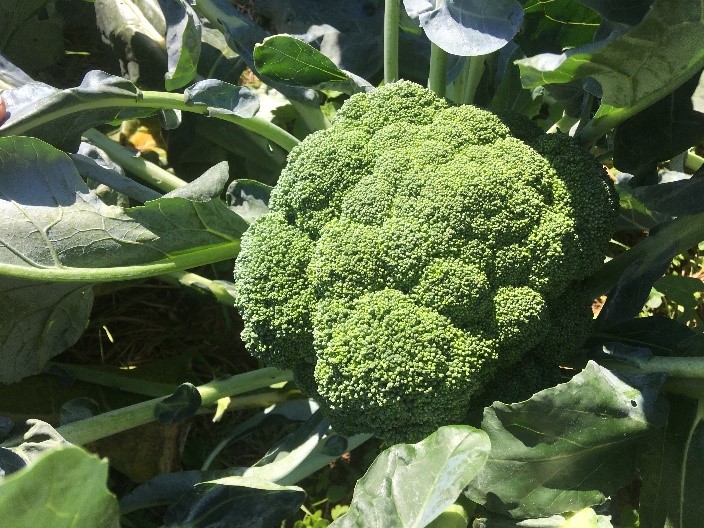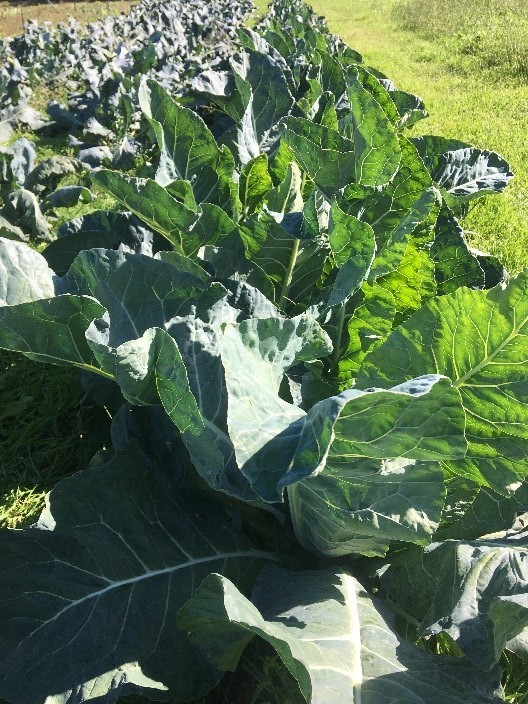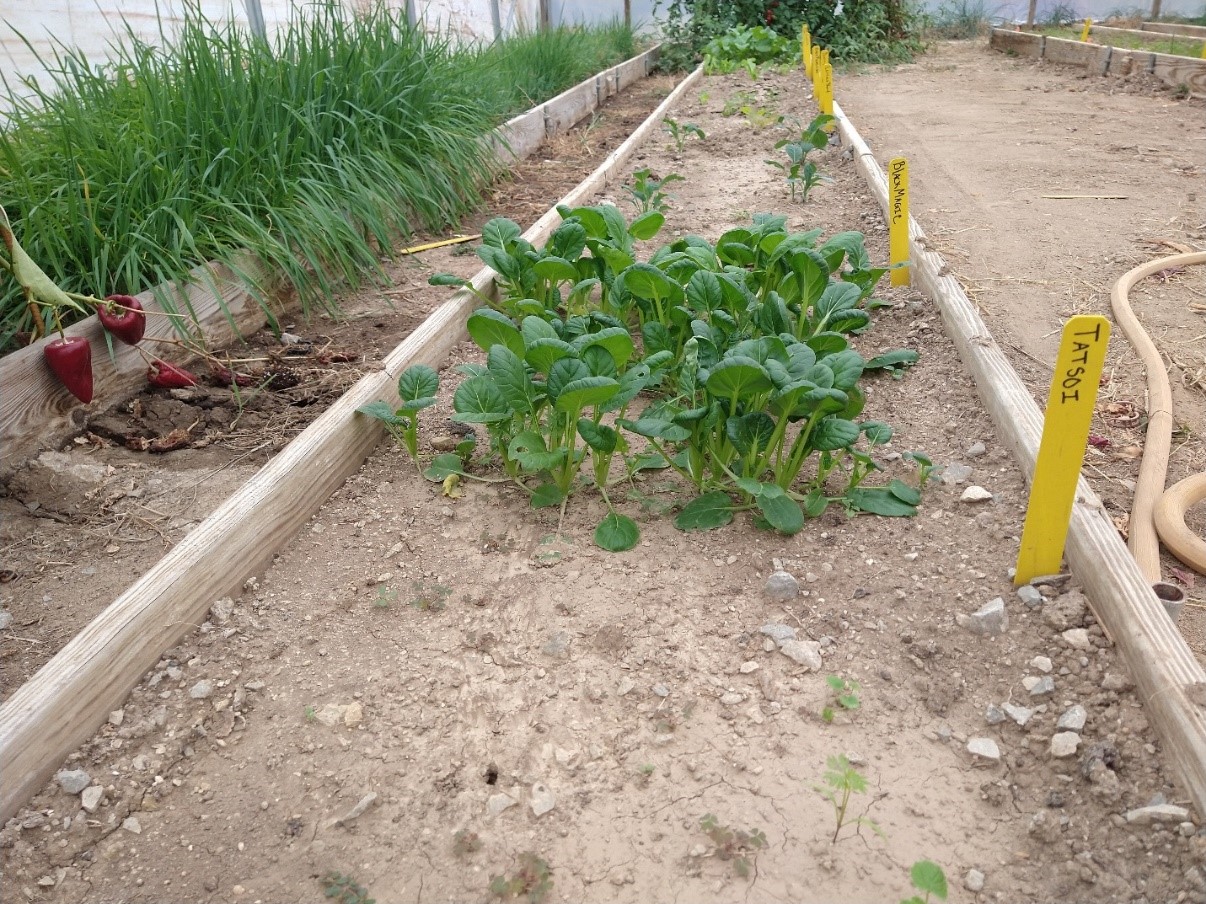Address any questions or comments regarding this newsletter to the individual authors listed after each article or to its editors, Nathan Johanning, 618-939-3434, njohann@illinois.edu or Bronwyn Aly 618-695-6060, baly@illinois.edu. The Illinois Fruit and Vegetable News is available on the web at: http://ipm.illinois.edu/ifvn/. To receive or be removed from email notification of new postings of this newsletter, contact Nathan Johanning or Bronwyn Aly at the phone numbers or email addresses above.
In This Issue:
Upcoming programs (listings for beginning and established growers)
News & Announcements (Local Foods, Local Farms, Local People)
Regional Reports (St. Louis metro east, southern Illinois (Murphysboro), southern Illinois (Waterloo), Dixon Springs)
Less Seriously
University of Illinois Extension educators and specialists in fruit and vegetable production and pest management
See the University of Illinois Extension Local Food Systems and Small Farms Team’s website at:
http://web.extension.illinois.edu/smallfarm/ and the calendar of events at http://web.extension.illinois.edu/units/calendar.cfm?UnitID=629.
- The Great Lakes Fruit, Vegetable & Farm Market Expo (GLEXPO) is returning to its traditional face-to-face format, and will be held December 7-9, 2021 at the DeVos Place in Grand Rapids, Michigan. Registration for the program itself will be coming at a later date, but you should make your room reservations now as hotels near the conference site tend to fill up quickly. Visit their website for additional details as they become available at https://glexpo.com/expo-schedule/ or visit their Facebook page at https://www.facebook.com/GLExpo/
- 2022 KY Fruit and Vegetable Conference will be held January 2-4, 2022 in Bowling Green, KY. Registration and conference information can be found at https://kyhortcouncil.org/2022-ky-fruit-vegetable-conference/
- 2022 Illinois Specialty Crops Conference is also returning to a face-to-face format January 5-7, 2022 at the Springfield Crowne Plaza. Our program team is well on their way to providing another great program, so we should have program details available in the coming months.
- Great Plains Grower School (Kansas, Missouri, Nebraska and Iowa) will be held January 7-8, 2022 in St. Joseph, MO. Registration and conference information can be found at https://www.greatplainsgrowersconference.org/
Local Foods, Local Farms, Local People – The brand new blog kicking off this month from the University of Illinois Extension Local Food Systems and Small Farms team starts with the article below.
Homework, teamwork, and passion power the real food for real people operation of central IL farmer
It was a strangely mild, pleasant, and cloudy day in early July when I visited with Jeremy Zobrist of Rock Creek Farms and sister company, Top Fox Snacks, based in Danvers IL, west of Bloomington-Normal. The topography, while approaching the Mackinaw River valley, is surprising. Yes, hills in central Illinois! –. Jeremy comes from a long line of cash grain farmers but is now growing pumpkins. This may seem really “out there” to those who don’t know that Illinois grows more than 90% of the country’s pie pumpkins. However, Jeremy has almost 1000 acres of pumpkins, not grown for pie filling, nor Jack-o-Lanterns, but for delicious, nutritious pumpkin seeds— Rock Creek Farm’s primary product.
Folks around here are used to the sight of acre upon acre of corn and soybean; therefore, it’s jarring to see a several hundred-acre field of pumpkins in central Illinois, but exciting too. Jeremy works with a handful of area farmers to achieve the acreage and scale necessary to justify mechanized pumpkin harvesting and processing equipment. One of these contract farmers explained that he really appreciated the opportunity to diversify his rotation away from cash grain to pumpkins. Jeremy elaborated, “contract growing of specialty crops is on the rise because farmers want and need more diverse rotations to avoid a buildup of pest pressure and other problems. They are looking for ways to steward their land better by reducing soil degradation, and this opportunity helps fulfill that goal. Additionally, grain farmers are taking pride in having stuff grown on their farm and showing up on stores shelves, especially if it’s a healthy food product.”
Specialty crops products being grown for farmers markets, small groceries stores, co-ops, and CSAs is not really a new phenomenon, even in the Midwest. Local foods and small farms production has taken off over at least the last decade, and shows no signs of slowing down. However, most of the farm products fueling this trend are from agricultural production, like honey, vegetables and fruits, mushrooms, flowers, and nuts. Only a small percentage of those products are value-added, where primary ingredients are combined and processed to achieve a greater value to the customer at a price premium friendly to the producer. Generally speaking, value-adding can be a challenge.
That said, Jeremy Zobrist is certainly not afraid of a challenge, and he’s overcome a few to get where he is today. He grew up a farm kid, on a farm producing corn, soybean, alfalfa and hogs. “So very much so I come from a traditional ag and farming experience. But I had a dream to do something beyond that. I knew I wanted to grow real food for people, I just didn’t know how I was going to get from Point A to Point Z.” But he put one foot in front of the other, got to work, and pursued the dream.
In a past life, Jeremy was a Certified Public Accountant; shortly after, he became part of the food industry by purchasing a stake in a food company, but his farm dreams were always in the back of his mind. So, he conducted a market analysis, to try to turn the company in a new direction, and back towards the farm dream. Jeremy saw it like this, “We wanted to do something different; we asked ourselves: what crop grows well in Illinois, that we can add value to, that would yield a product that consumers already buy at scale, that there is a domestic supply chain need for?” The answer is pumpkins, for pumpkin seeds.
Currently, the U.S. imports tons of pumpkin seeds per year from China. Jeremy saw that the need was there, and to help close the gap domestically would be an added bonus. According to Michigan State University Extension, 100g of pumpkin seeds contains almost 6 grams of protein, and almost as much fat and fiber. Additionally, most of the fat in pumpkin seeds are mono and polyunsaturated i.e. healthy fats. Jeremy’s dream to be able to grow something healthy on the farm for direct consumption began to take shape.
Since having that “ah-hah” moment, Jeremy, his wife and team have annually attended “the school of hard knocks, for sure.” But they’ve kept at it— starting with 20 acres of pumpkins, while growing some backup grain crops. This year, four seasons in, they’re growing 1000 acres, and are shooting for almost 2000 acres of on-farm and contract pumpkins next season. Top Fox Snacks pumpkin seed products are now available on Amazon and in local grocery stores as well as chain grocers like Sprouts, Safeway, and Hy-Vee. Check out the “seeds” of their story here!
Jeremy explains the biggest challenge for Illinois specialty crops growers as “always, always marketing, or the market. If you have a really strong demand for your product, a lot of the other problems will get figured out pretty quick.” But do your consumers want or need what you’re selling, at a price you can make a little money at? Jeremy offers sage advice for farmers seeking new markets: “It’s always sexy and exciting to plant a new, cool crop, but if nobody will buy it (when they figure out what it is and what they should do with it), then you have at best a hobby and at worst a losing proposition. That’s brutal, and nobody in the local foods movement wants to hear that, but it’s real. There’s a psychological component here: is what I’m doing even worth doing? But if you’ve done your homework, trialed some products and you know you have a market and you know someone will pay some amount that will allow you to profit, even a little bit, you can deal with the day-to-day psychology. Otherwise, it’s not worth it and burnout, disillusionment and pain will follow.”
As for the future of the operation, in addition to scaling up the acreage, Jeremey is working on improving their business marketing their agronomic systems to make their crops more climate change-resistant; and their harvest, drying, cleaning, and packaging techniques. Jeremy attributes their day-to-day success to “building the best team possible. Nothing, and I mean nothing gets done without a great team.”
Borrowing from the late Chris Blanchard and his Farmer to Farmer Podcast, I asked Jeremy these last two questions.
Favorite crop to grow:
“My first love was and always has been corn. There’s a unique smell of corn dust in the field during harvest on a nice fall day with a chill in the air. Then there’s the sights and sounds of 250 bushels of corn and the auger wagon struggling to keep up with the combine. There’s something romantic and visually appealing about how it grows all year, EVEN IF it doesn’t make you any money some years. Practically, though, the answer to your question is pumpkins.”
If you could go back in time and tell your beginning farmer self one thing, what would it be?
“Have faith! You’ll figure it out!” As long as you’re willing to be humble and hungry and build a good team. Be grateful for the school of hard knocks, because that’s where you will learn the most.”
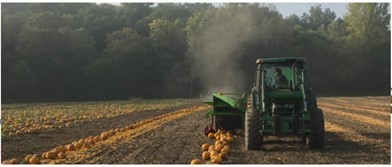
Fall pumpkin harvest on Rock Creek Farms, 2020; Photo Credit: Jeremy Zobrist
Nick Frillman (309-663-8306; frillma2@illinois.edu)
From St. Louis metro east… The landscape is slowly changing as corn and soybean fields are harvested. Leaves are just starting to turn but for the most part the color green still dominates the canopy. Temperatures have been relatively warm, sometimes reaching a daytime high in the low 90s. The middle of October though brought a cold front which has returned the region to more normal fall temperatures. Rain has been consistent throughout, and soils have been a bit slower to dry with the recent cool down.
Some stand-alone farm markets have closed for the season, but orchards and pumpkin farms are still in their busy season. Apples are in the Fuji/EverCrisp harvest window and pumpkins are still in demand.
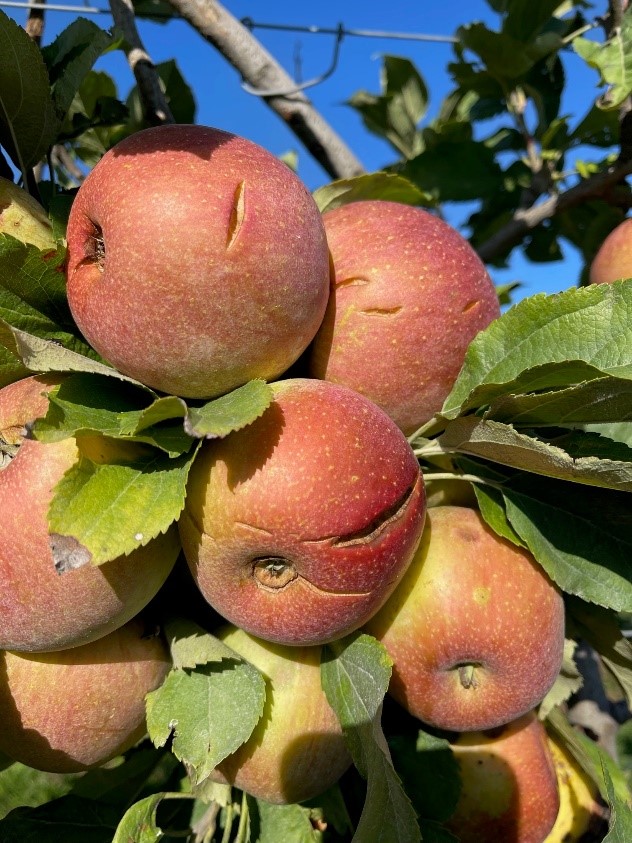
Blossom end and sidewall cracking on ‘EverCrisp’. Grower provided image with permission
After sharing an IL report of EverCrisp cracking, other growers from other states are also reporting similar problems. Usually, a big rain event is the culprit, especially following a dry period, but some cultivars are especially prone to cracking (i.e. Stayman, Fuji, Gala Golden Delicious, etc.). EverCrisp is a relatively new release, so it will take some time to assess the problem and develop management strategies, but several management strategies are being looked at based on other crack-susceptible cultivars. For example, low boron levels can predispose apple fruit to cracking and external cork symptoms even thought the foliage may show no symptoms. ProVide plant growth regulator is a management strategy for reducing cracking in some crack-prone cultivars and may offer some solutions. And the third management strategy to look at is the role Apogee plant growth regulator has in promoting cracking in EverCrisp. Apogee appears to cause fruit cracking in Empire and Staymen under certain conditions and is noted as such on the label.
Elizabeth Wahle (618-344-4230; wahle@illinois.edu)
From southwestern Illinois (Waterloo)… We have finally cooled off to more “normal” temperatures for the late part of October. Highs have been in the 60s and lows in the 40s generally speaking. We have had 1” of rain over the weekend (10/23-25). We were fortunate here to have missed any severe weather, but there was some damage in Randolph County with a tornado near Chester, IL. Soil moisture high; however, we haven’t fortunately just had multiple inches of rain in excess (hopefully it stays that way). It is looking like a fairly dry but cool end of October and start to November. We have not had any frost/freeze yet but the forecast shows that will be coming in early November.
Out in the field right now, things are winding down. It overall has been a very warm fall and a fairly good fall growing season. Moisture has been available but not excessive. The warm temperatures until mid-October, put some stress on fall planted cole crops. I have a planting of fall broccoli and cauliflower, no-till transplanted. The early head of broccoli started coming off about October 15 and while it tasted good the tightness and formation of the beads was not as consitent as some of the heads coming off later. The cauliflower is a little later and still has small heads on it. This is by first attempt at growing fall cauliflower. This variety is ‘Toledo’ which is self-blanching Fall cover crops are also doing well with some moisture and good temperatures for growth.
Fall Broccoli (variety ‘Millennium’) on the left. Fall planted cauliflower (variety ‘Toledo’) still forming head (right). Both were no-till transplanted in mid-August. Photos: N. Johanning
Pumpkin season has been very good for most people I have talked with. Across the region demand has been good and overall. The crop has been good as well. On our farm, We had a very dry August, this tended to reduce the size of first harvest of jack-o’-lanterns somewhat; however, with some rainfall there was a very nice later set that sized very nicely. The warm fall had kept later fruit ripening well.
The largest issue I and many others in our area have had with pumpkins is melonworms. I have had these first back in 2015 and shared my notes in the newsletter at that time (https://ipm.illinois.edu/ifvn/contents.php?id=69). I have seen them occasionally since, but this year has been far worse. I have had reports from at least a half dozen other farms in the area that have also had very significant problems as well. Many of which reported significant losses of marketable fruit due this pest; one grower reported losing over an acre due to the damage being just enough it rendered them unmarketable. Fruit do not usually rot from feeding; however, they often feed around the stem or on the fruit enough to scar and mess up the fruit appearance. This is a big deal for a crop that is basically used largely for its appearance and decoration. I think this pest is manageable but I think it came and many growers were not used to scouting for it so by the time it was noticed a great deal of damage was done. I had sprayed earlier in September with good results, but had not since and especially with the warm the populations have really exploded in these final weeks of the pumpkin season. We still were able to get the fruit we needed but its very frustrating to pick up, what you think is a nice pumpkin just to find it had damage like this. We will share more about this pest and management tactics in future issues.
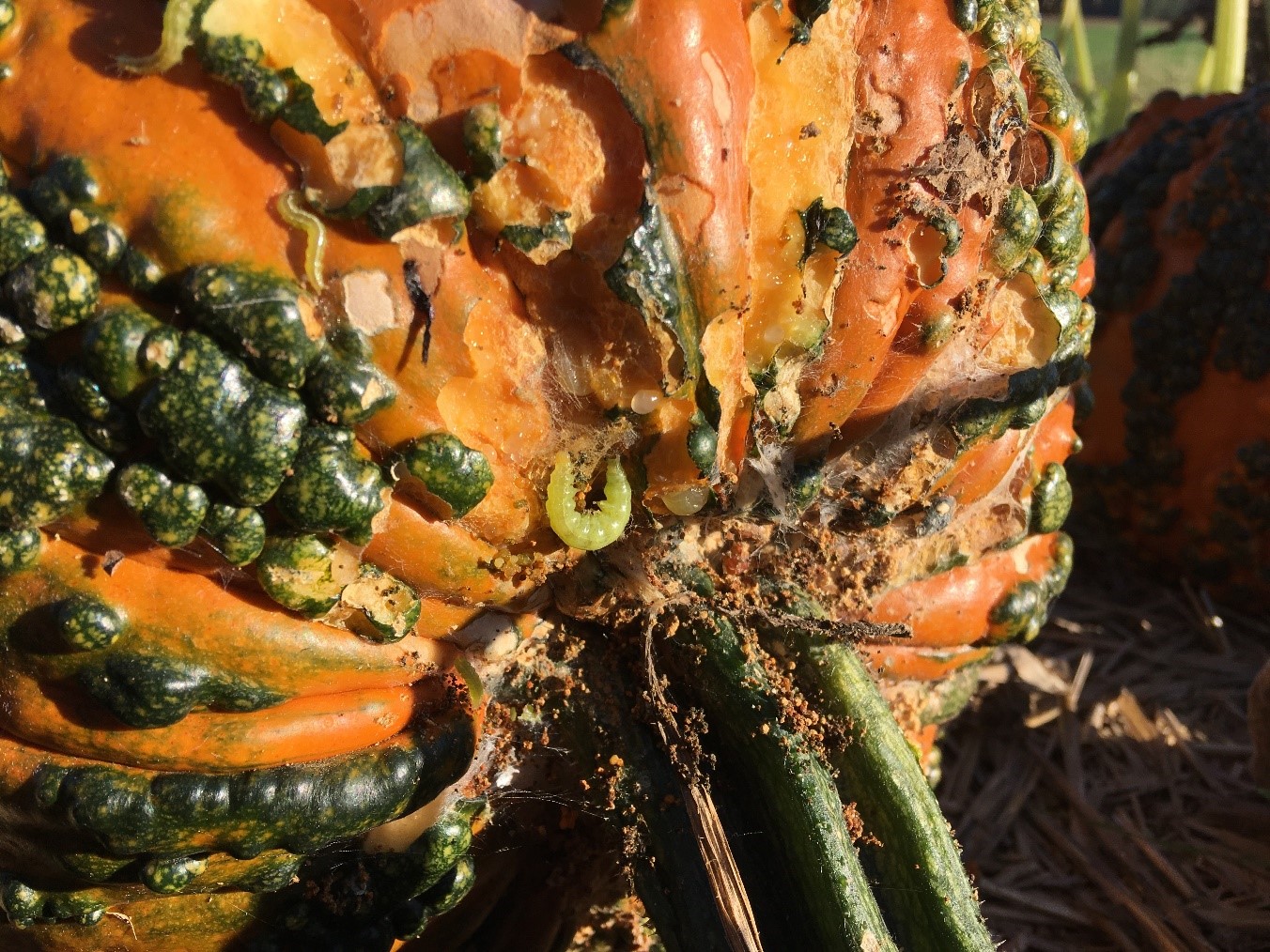
Example of feeding from melonworms on pumpkins (variety ‘Warty Goblin’). Photo: N. Johanning
Thank you to all who offered kind words, thoughts and prayers after the loss of our infant daughter Esther Lou https://quernheimfuneralhome.com/obituaries/esther-johanning-1. We apprecaite greatly all of the support and understanding of all.
Nathan Johanning (618-939-3434; njohann@illinois.edu)
From southern Illinois (Murphysboro)… After an extended period of warm temperatures, we are finally getting some fall weather. The recent storm systems have brought in cool temperatures and cloudy skies here in southern Illinois. We only recently removed the shade cloth from the high tunnel because of the warm temperatures in early October.
Here at the Jackson County office we have nearly finished with fall clean-up and are getting into the swing of the fall growing season. Currently, we have spinach, tatsoi, radishes, butter crunch lettuce, and 6 varieties of colored carrots planted in the high tunnel. I am also starting to make plans for next year’s growing season and planting fall cover crops.
Carrots (left) and taisoi (right) planted in high tunnel at Jackson Co. Extension office. Photos by K. Bell.
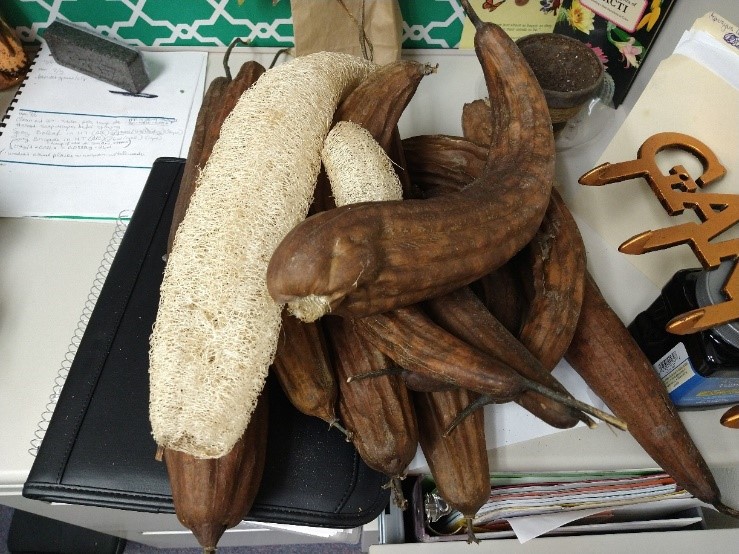
Loofah gourds grown at the Jackson Co. Extension office. Photo by K. Bell.
The higher temperatures in October extended the growing season enough to allow us to harvest 15 loofah gourds. The gourds should be mostly or completely brown before harvesting. After harvesting allow them to dry for a few days and then remove the seeds and outer husk. For more information on harvesting and preparing loofahs check out this video.
As always have a happy and safe fall!
Katie Bell (618-687-1727; klbell@illinois.edu)
From Dixon Springs Ag Center…The latter part of October has brought us more normal fall temperatures and a bit of rain to settle the dust. We have begun removing some of the plants in our various research and demonstration plots within our high tunnels at DSAC. Harvest has continued on tomatoes, peppers, cucumbers and strawberries and the majority of this late season produce has been donated to local food pantries. The peppers have had a surge in production in this last month, with the majority of the fruit sizing very well. Tomatoes have slowed in their ripening and I expect we will clean off the last of the green fruit prior to the potential frost that might hit our area later next week.
The hydroponic strawberries are maintaining good flavor and quality, and the most noticeable observation on these plots is the continued lack of spider mites. These strawberries were over-run with spider mites earlier in the season (July/August) but were hit with an additional application of a different predatory mite that really did a great job in cleaning up the spider mite population. The earlier applications of predatory insects being used as a biological control strategy had just not been able to get ahead of the spider mite population, but this additional insect release really was impressive.
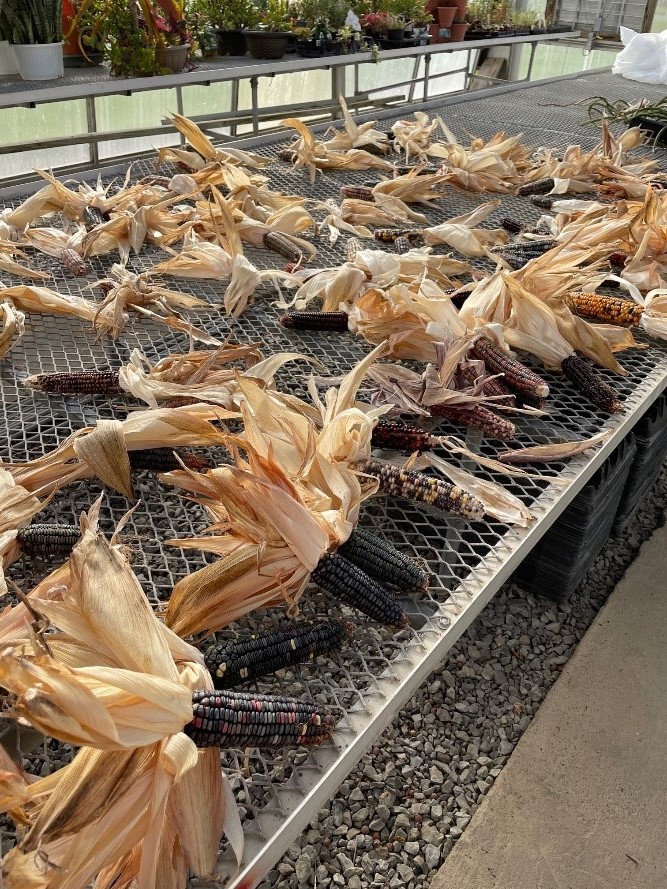
Ornamental corn harvested from a small plot at DSAC. Photo by B. Aly.
About two weeks ago, we harvested the small patch of specialty pumpkins, ornamental corn and broom corn that we planted in coordination with our Unit 24 4-H ers. Each ear of ornamental corn feels like opening a present, the excitement and anticipation of what colors will be revealed when you pull back the husks.
Looking forward to seeing everyone in Springfield this year at the 2022 Illinois Specialty Crops Conference!
Bronwyn Aly (618-382-2662; baly@illinois.edu)
Hey, batter batter…See if you can splat her!
Highlight photo from the 2021 DSAC Tomato World Series

Photo by B.Aly
University of Illinois Extension Educators and Specialists in Fruit and Vegetable Production and Pest Management
University of Illinois Extension Specialists in Fruit and Vegetable Production & Pest Management
Extension Educators – Local Food Systems and Small Farms |
Bronwyn Aly, Gallatin, Hamilton, Hardin, Pope, Saline, and White counties |
618-382-2662 |
baly@illinois.edu |
Katie Bell, Franklin, Jackson, Perry, Randolph, & Williamson counties |
618-687-1727 |
klbell@illinois.edu |
Sarah Farley, Lake & McHenry counties |
847-223-8627 |
sfarley@illinois.edu |
Nick Frillman, Woodford, Livingston, & McLean counties |
309-663-8306 |
frillma2@illinois.edu |
Laurie George, Bond, Clinton, Jefferson, Marion, & Washington counties |
618-548-1446 |
ljgeorge@illinois.edu |
Zachary Grant, Cook County | 708-679-6889 | zgrant2@illinois.edu |
Doug Gucker, DeWitt, Macon, and Piatt counties |
217-877-6042 |
dgucker@illinois.edu |
Erin Harper, Champaign, Ford, Iroquois, and Vermillion counties |
217-333-7672 |
harper7@illinois.edu |
Grace Margherio, Jackie Joyner-Kersee Center, St. Clair County |
217-244-3547 |
gracem@illinois.edu |
Grant McCarty, Jo Daviess, Stephenson, and Winnebago counties |
815-235-4125 |
gmccarty@illinois.edu |
Katie Parker, Adams, Brown, Hancock, Pike and Schuyler counties |
217-223-8380 |
keparkr2@illinois.edu |
Kathryn Pereira, Cook County |
773-233-2900 |
kpereira@illinois.edu |
James Theuri, Grundy, Kankakee, and Will counties |
815-933-8337 |
jtheu50@illinois.edu |
Extension Educators – Horticulture |
Chris Enroth, Henderson, Knox, McDonough, and Warren counties |
309-837-3939 |
cenroth@illinois.edu |
Richard Hentschel, DuPage, Kane, and Kendall counties |
630-584-6166 |
hentschel@illinois.edu |
Andrew Holsinger, Christian, Jersey, Macoupin, & Montgomery counties |
217-532-3941 |
aholsing@illinois.edu |
Extension Educators - Commercial Agriculture |
Elizabeth Wahle, Fruit & Vegetable Production |
618-344-4230 |
wahle@illinois.edu |
Nathan Johanning, Madison, Monroe & St. Clair counties |
618-939-3434 |
njohann@illinois.edu |
Campus-based Extension Specialists |
Kacie Athey, Entomology |
217-244-9916 |
kathey@illinois.edu |
Mohammad Babadoost, Plant Pathology |
217-333-1523 |
babadoos@illinois.edu |


